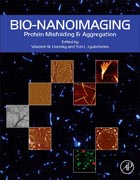
Bio-nanoimaging: Protein Misfolding & Aggregation
Uversky, Vladimir
Lyubchenko, Yuri
Bio-Nanoimaging: Protein Misfolding & Aggregation provides a unique introduction to both novel and established nanoimaging techniques for visualization and characterization of misfolded and aggregated protein species. The book is divided into three sections covering: - Nanotechnology and nanoimaging technology, including cryoelectron microscopy of beta(2)-microglobulin, studying amyloidogensis by FRET; and scanning tunneling microscopy of protein deposits - Polymorphisms of protein misfolded and aggregated species, including fibrillar polymorphism, amyloid-like protofibrils, and insulin oligomers - Polymorphisms of misfolding and aggregation processes, including multiple pathways of lysozyme aggregation, misfolded intermediate of a PDZ domain, and micelle formation by human islet amyloid polypeptide Protein misfolding and aggregation is a fast-growing frontier in molecular medicine and protein chemistry. Related disorders include cataracts, arthritis, cystic fibrosis, late-onset diabetes mellitus, and numerous neurodegenerative diseases like Alzheimer's and Parkinson's. Nanoimaging technology has proved crucial in understanding protein-misfolding pathologies and in potential drug design aimed at the inhibition or reversal of protein aggregation. Using these technologies, researchers can monitor the aggregation process, visualize protein aggregates and analyze their properties. Provides practical examples of nanoimaging research from leading molecular biology, cell biology, protein chemistry, biotechnology, genetics, and pharmaceutical labsIncludes over 200 color images to illustrate the power of various nanoimaging technologies Focuses on nanoimaging techniques applied to protein misfolding and aggregation in molecular medicine INDICE: Part 1. Nanotechnology and nanoimaging of aggregating proteins Nanoimaging of aggregated proteins; Cryoelectron microscopy of beta(2)-microglobulin; Amyloid fibril length quantification by AFM; Seeing fibril formation in real time; Studying amyloidogensis by FRET; Structure, growth and assembly of amyloid-like fibrils using high-speed atomic force microscopy; Analyzing amyloid fibril structure by scanning transmission electron microscopy; Magic angle spinning NMR of amyloid fibrils; Analyzing protein deposits in vivo by confocal laser multiphoton laser scanning microscopy; Amyloid imaging agents; Reporters of amyloid structure; Immunohistochemical detection of amyloid components; Scanning tunneling microscopy of protein deposits; Probing of protein misfolding with single molecule force spectroscopy; Single molecule characterization of a-synuclein in aggregation-prone states Part 2. Polymorphism of protein misfolded and aggregated species Fibrillar polymorphism; Ab fibril polymorphism; Prefibrillar Ab oligomers; Structural heterogeneity of in vitro and ex vivo amyloid assemblies; Polymorphism of tau fibrils; Amyloid-like protofibrils with different physical properties; Micelle-Like Architecture of the Amyloid-ß Peptide; Insulin oligomers; Worm-like amyloid fibrils of mouse prion protein; Apolipoprotein C-II Amyloid Fibrils; Amylin oligomers and fibrils; Amyloid fibrils of human stefins; Fibrillar structure of Sup35 in vivo; Dopamine-induced a-synuclein oligomers ; Amyloid spherulites; A stable lipid-induced aggregate of alpha-synuclein Part 3. Polymorphism of protein misfolding and aggregation processes Multiple pathways of lysozyme aggregation; Structure-function study of amyloid ion channels in neurodegenerative diseases; Amyloid ß-protein assembly; Molecular mechanisms underlying alpha synucelin misassembly; Multiple pathways of amyloid assembly /disassembly studied by AFM; Sequestering of metastable proteins with essential cellular functions by amyloid-like aggregates; Misfolded intermediate of a PDZ domain; Structural characterization of the amyloidogenic state of human lysozyme; Landscape Model of Filamentous Protein Aggregation; Micelle formation by human islet amyloid polypeptide; Effect of anionic polysaccharide on ß-lactoglobulin fibrillation
- ISBN: 978-0-12-394431-3
- Editorial: Academic Press
- Encuadernacion: Cartoné
- Páginas: 552
- Fecha Publicación: 07/01/2014
- Nº Volúmenes: 1
- Idioma: Inglés
